George S. Stuart
George Stuart (born 1929) is an American sculptor, raconteur and historian. He has traveled the United States presenting historical monologues about the last four centuries in the Americas, Europe, Russia and China. To help audiences visualize the personalities in his monologues, Stuart created over 400 historically accurate, quarter life-size sculptures of personages with political influence from the 16th to the 19th century. His works have been exhibited in The Smithsonian and Clinton Presidential Library as well as at other museums and libraries throughout the United States.
George S. Stuart | |
|---|---|
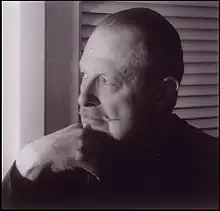 Artist-Historian George S. Stuart | |
| Nationality | American |
| Known for | Sculptor |
| Notable work | Gallery of Historical Figures, Museum of Ventura County, Ventura, California; |
Early career
As a young boy, Stuart traveled to Europe and became increasingly interested in historical architecture. In his teens, he constructed a scale model of the French Palace of Versailles[1] and began to experiment with the human form after receiving an articulated marionette as a gift. Illness deterred him for a time, but he persisted and enrolled in first Georgetown University then the American University in Washington, D.C. where he studied history, economics, languages and international law to prepare to become a Foreign Service Officer. But his academic career was frustrated by dyslexia, a condition not recognized in those days.[2]
Then, in the early 1950s, he was offered a position at the Smithsonian Institution, where he sculpted figures of inventors to accompany patent models exhibited there. As a member of the Smithsonian staff, he also participated in the development of the Presidents' Wives exhibit.
After Stuart completed a degree in Fine Arts at the University of California in Santa Barbara, where he found himself drawn to theater arts,[3] he began touring the country performing historical monologues accompanied by eight to twelve of his figures.[4] He was represented by the Samuel Horton Brown Agency in Beverly Hills, joining the firm's other clients including Margaret Meade.[5] Focusing on power and political intrigue, Stuart developed over 20 programs using his historical figures as visual aids.[6]
When Stuart moved to Ojai, California in 1959, he opened The Gallery of Historical Figures and began teaching workshops on figural construction, costuming and sculpting faces. In 1991, the city of Ojai presented Stuart with its Lifetime Achievement in the Arts award. He also has been recognized by the United States Congress.
"Historical Figures"
Each historical figure begins with a jointed iron wire skeleton in quarter scale that is designed to move like the treasured marionette from Stuart's childhood. The head is modeled separately, beginning with a skull structure built up with clay then molded in plastic. The facial features are defined using a jeweler's loup and fine instruments. Blown glass eyes are then inserted from the inside. [6] The body is then built up with papier maché, cotton fiber, and styrofoam enclosed with wool felt skin. After he chooses an appropriate pose, the figure is then finished with a custom plastique that Stuart developed himself after years of experimentation to achieve the look of life-like skin.[5]
He has created more than 400 "Historical Figures" in groups to complement his performances.[7] The groups include, American Revolutionary and Civil Wars (Samuel Adams to Abraham Lincoln), English Monarchies (Henry VII to Edward VII), Bourbon Dynasty (Henry IV to Charles X), Czarist Russia (Ivan IV to Joseph Stalin) Manchu Dynasty (Nurhaci to Mao Tse-tung, Renaissance & Reformation (various rulers and clergy), Conquest of the Americas (Columbus to John Fremont), Really Awful People (including Hitler, Stalin, Mao, Attila the Hun, Vlad the Impaler, Nero, Ivan the Terrible, and the Borgias), Warriors of the Ages, Germanic Myth & Legend (northern pantheon) and his earliest works.
One of his most popular presentations focused on history's "Really Awful People" group.
"The story begins with a massacre and ends with a slaughter," Stuart observed. "In between we have murder, rape, sex violence, intrigue and political chicanery."
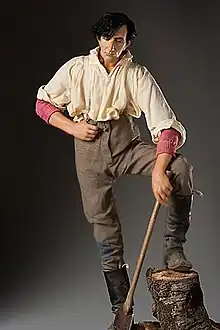
Stuart reported his most popular figurines are those of Lincoln. He produced five different versions of Lincoln from his early years to his appearance at the time of the 16th president's assassination.[2] His figures from the American Revolutionary and Civil War periods were featured in the exhibit "Revolution and Rebellion: Wars, Words and Figures." at the William J. Clinton Presidential Library in September, 2011.[8]
Stuart's quest for historical accuracy led him to import specially-scaled chain mail, embroidered silks,[9] and Icelandic sheepskin for life-like hair.[2] Stuart fabricated historically accurate metal helmets, armor, weapons, crowns, and accessories.[9]
More than 200 of Stuart's Historical Figures now reside in the permanent collections of the Museum of Ventura County where a special gallery was constructed for their display. Other figures are in the collections of the Naples Museum of Art in Naples, Florida. Temporary exhibits have been held at the Pasadena Museum of History, the Ojai Valley Museum of History and Art, the Oxnard Library, California State University, and the William J. Clinton Presidential Library and Museum.
Gallery
 Comanche Warrior
Comanche Warrior James I
James I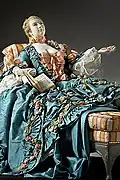 Jeanne Antoinette Poisson, Madame de Pompadour
Jeanne Antoinette Poisson, Madame de Pompadour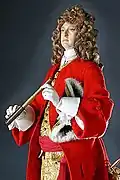 John Churchill, 1st Duke of Marlborough
John Churchill, 1st Duke of Marlborough Norman Knight
Norman Knight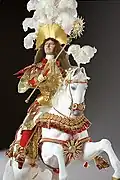 French King Louis XIV
French King Louis XIV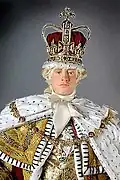 King George III in Robes of State
King George III in Robes of State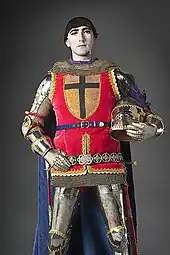 Gilles de Retz
Gilles de Retz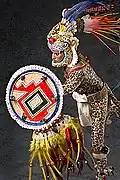 Aztec Leopard Warrior
Aztec Leopard Warrior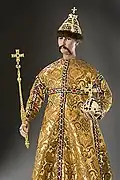 Tsar Boris Godunov
Tsar Boris Godunov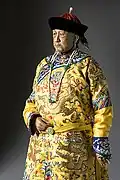 Chinese Emperor Chien Lung
Chinese Emperor Chien Lung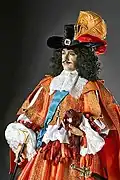 King Charles II
King Charles II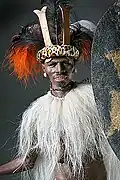 Zulu Warrior
Zulu Warrior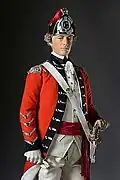 Sir John Burgoyne
Sir John Burgoyne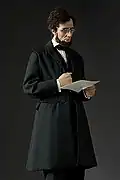 Abraham Lincoln
Abraham Lincoln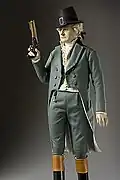 Alexander Hamilton
Alexander Hamilton Cesare Borgia
Cesare Borgia Alexander II Nikolaevitch
Alexander II Nikolaevitch Chumash Family
Chumash Family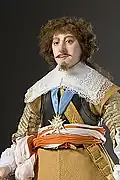 Gaston D'Orleans
Gaston D'Orleans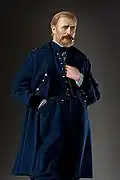 General Ulysses S. Grant
General Ulysses S. Grant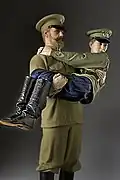 Tsar Nicholas II Romanov and Tsarevich Alexei
Tsar Nicholas II Romanov and Tsarevich Alexei Regent Philippe d'Orleans
Regent Philippe d'Orleans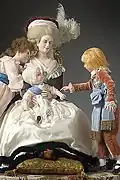 Queen Marie Antoinette with her children
Queen Marie Antoinette with her children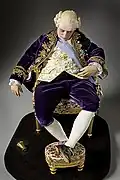 King Louis XVI in 1780
King Louis XVI in 1780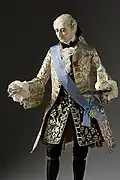 King Louis XV in 1745
King Louis XV in 1745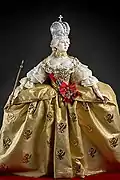 Empress Catherine II of Russia
Empress Catherine II of Russia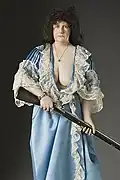 Russian Empress Anna Ivanova
Russian Empress Anna Ivanova King Henry VIII
King Henry VIII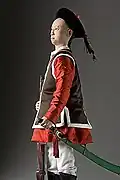 Chinese Bannerman
Chinese Bannerman
References
- David Kelly, "Fascinated by figurines". Los Angeles Times, as reprinted in the Montreal Gazette, September 10, 2001: E5.
- Davis, Ivor (October 2009). "Making History". Ventana Monthly: 32–35.
- Robertson, Carmen. "Historical Figures One Man's Passion". The Gold Book: 154–161.
- Seiden, Ellen (October 2009). "Three Dimensional Portrait Humanize History: George Stuart Historical Figures". Renaissance Magazine. 12 #5 (57): 30–31.
- Coyner, Barbara (November–December 1997). "A Man of Many Faces". Art of the West (10th Anniversary): 78–82.
- Kidder, Fred (September 2002). "Old Shop: George Stuart". Figure International.
- "The Art & Imagination of George Stuart". www.galleryhistoricalfigures.com. Retrieved 2016-02-24.
- "Revolution and Rebellion: Wars, Words and Figures". Sons of the American Revolution Magazine. 105 (3): 14–15. September 2011.
- Golden, Alan (October 2010). "Welcome to the world of George S. Stuart". Toy Soldier Magazine (149): 20–26.
Related publications
- Green, Lee (2004). George Stuart's Historical Figures. Ventura County Museum of History and Art. ISBN 0-9729361-2-2.
- Kettmann, Kevin (2004). "The Art of History, The Fascinating Figurines of George Stuart". Ventura Magazine (Fall).
External links
- Historical Figures of George Stuart (official website).
- Introducing George Stuart and his Historical Figures (video).
English History
- Prince Albert
- Prince Albert Victor
- Alexandra Princess of Wales 1
- Alexandra Princess of Wales 2
- Queen Anne
- Beau Brummel
- Anne Boleyn
- Bonnie Prince Charlie
- Benjamin Disraeli
- Cardinal Woolsey
- Caroline von Anspach
- Caroline Von Brunswick
- Catherine of Aragon
- King Charles I
- King Charles II
- Queen Charlotte Sophia
- Countess of Darlington
- King Edward VI
- Edward Prince of Wales
- Queen Elizabeth I
- Earl of Essex
- Florence Nightingale
- King George I
- King George II
- King George III in robes of state
- King George III circa 1780
- King George III circa 1818
- King George IV
- George Villiers Duke of Buckingham
- Queen Henrietta Maria
- King Henry VII
- King Henry VIII
- Sir Henry Clinton
- Jack the Ripper
- King James I
- King James II
- John Brown
- Sir John Burgoyne
- John Churchill Duke of Marlborough
- John Knox
- Duchess of Kendal
- Maria Fitzherbert
- Mary Stuart
- Mary Tudor
- Nell Gwynne
- Oliver Cromwell
- Oscar Wilde
- Sarah Churchill Duchess of Marlborough
- Queen Victoria circa 1837
- Queen Victoria circa 1860
- Queen Victoria circa 1900
- King William III
- William Gladstone
- Sir William Cecil-Burleigh
Russian History
- Tsar Alexander I
- Tsar Alexander II
- Tsar Alexander III
- Empress Alexandra Fedorovna
- Tsarevich Alexei Nikolaevich
- Tsar Alexis Mikhailovich
- Tsarevich Alexis Petrovich
- Anastasia Romanova
- Empress Anna Ivanova
- Boris Godunov
- Empress Catherine I
- Empress Catherine II
- Empress Catherine II in robes of state
- Empress Elizabeth I
- Eudoxia Lopukhina
- Gregory Rasputin
- Prince Grigory Potemkin
- Tsar Ivan IV The Terrible
- Tsar Ivan V
- Joseph Stalin
- Baroness Krudener
- Empress Marie Feodorovna
- Tsar Michael Romanov
- [*Baroness Krudener Natalia Narishkina]
- Tsar Nicholas I
- Tsar Nicholas II
- Patriarch Nikon
- Paul I
- Tsar Peter The Great
- Tsar Peter III
- Patriarch Philaret
- Tsarevna Sophia Alekseyevna
- Russian Serfs Liberation
- Stenka Razin
- Vladimir Lenin
- Yemelyan Pugachev